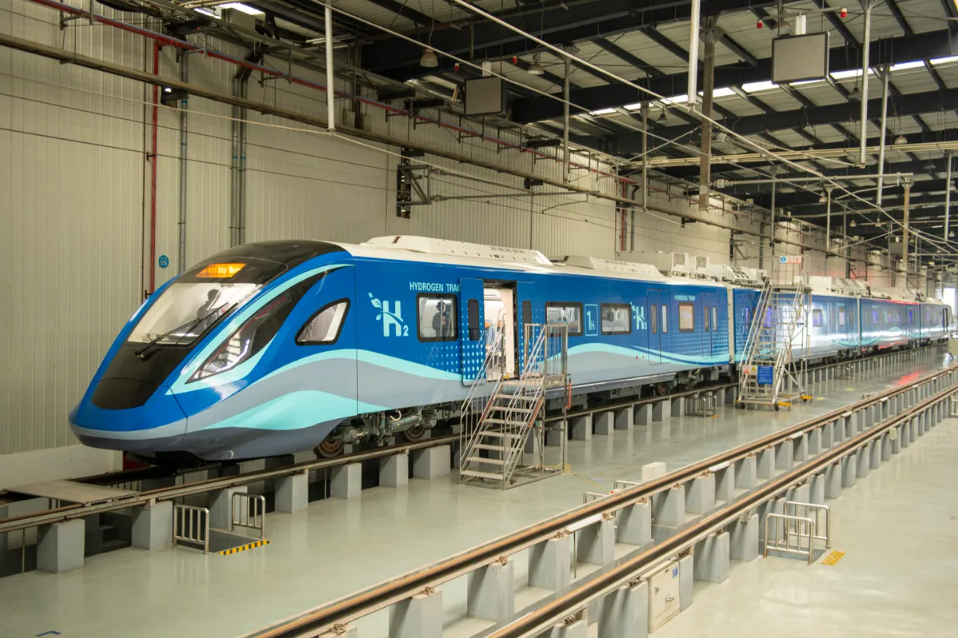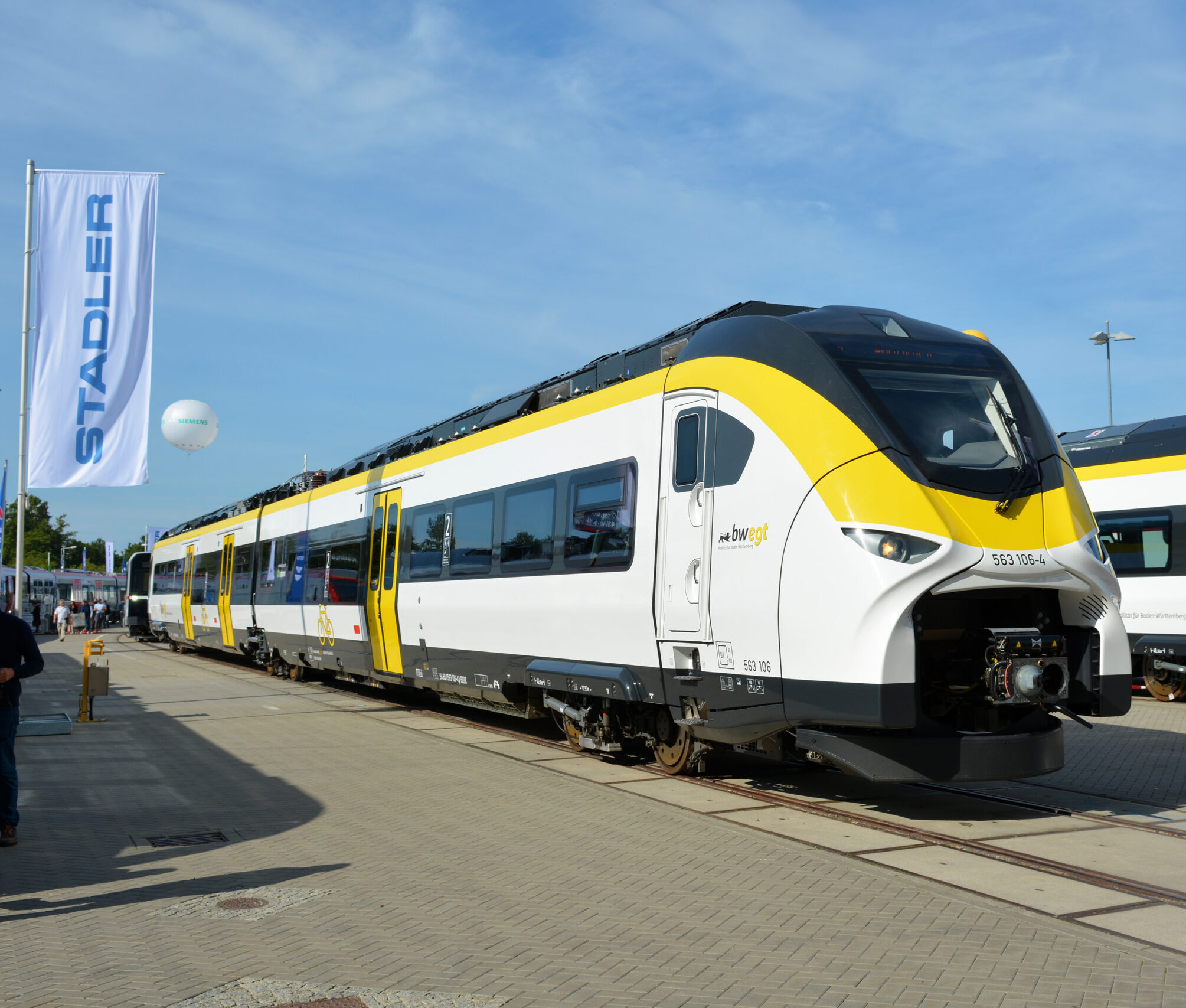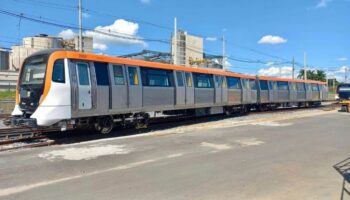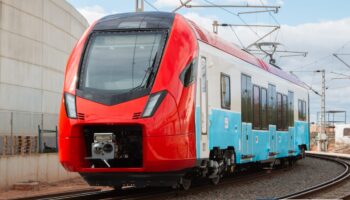One of the main trends in railway transport in recent years is replacing diesel engines with alternative ones. This trend is shaped by three factors. Firstly, the world has set a course to reduce greenhouse gas emissions to achieve the UN’s Sustainable Development Goals. Secondly, diesel rolling stock on non-electrified lines is reaching the end of its service life. Thirdly, operators look for a replacement for the familiar and optimal in many respects, but time-consuming and financially demanding electrification.
From Rolling Stock Market Trends almanac issued for the PRO//Motion.Expo 2023 International Railway Fair
As all major manufacturers are responsive to market demands, they develop rolling stock on alternative traction. Usually, it is either hydrogen or battery, but potential buyers may be offered hybrid vehicles that combine two or even three traction types, including catenary or diesel. Some companies experiment with alternative fuels like natural gas or biofuel in traditional internal combustion engines. At the same time as alternative traction is being promoted, comparative studies are actively conducted around the world to assess its economic feasibility. However, the results of such studies largely depend on the period for which the cost of electricity, diesel, fuel cells, batteries, creation of infrastructure, etc. are taken.
Hydrogen trains
The advantages of hydrogen trains include zero CO2 emissions, virtually no noise, and higher efficiency than diesel. Hydrogen, however, is produced using non-renewable energy sources, so the carbon neutrality of such solutions is questionable. In addition, the cost of its purchase and transportation is still quite high, and it is impossible to use this substance without creating an appropriate refuelling infrastructure.
There are two key hydrogen technologies on the market today. The first, fuel cells, involves generating electricity through cool-flame combustion of hydrogen and oxygen with the release of by-products, water condensate and vapour, and accumulation of excessive energy in batteries. When the second technology, hydrogen-diesel mixture, is used, hydrogen increases the efficiency of an internal combustion engine and reduces emissions.
The pioneer in the serial production of hydrogen trains was Alstom, France, which developed the Coradia iLint train with hydrogen fuel cells. In 2018, the trains went into pilot operation in Germany, and in 2022, a fleet of 14 two-car hydrogen trains started commercial service on a 100 km route in northern Germany for the first time in the world; this was the 100% hydrogen train route. According to the customer, the Local Transport Authority of Lower Saxony, the trains save about 1.6 mln l of diesel fuel and help reduce CO2 emissions by 4,400 t yearly. However, according to the latest news, the customer has cancelled further purchases due to high operating costs and chose battery traction instead.
To date, Alstom’s contracts provide for the delivery of 27 Coradia iLint trains to Germany, 14 to the Italian operator FNM, and 12 to France. Austria, the Netherlands, Poland, and Sweden have already seen the pilot runs of its hydrogen trains, there are tests in Canada now, and plans for tests in Saudi Arabia.
The Coradia iLint power plant consists of two fuel cell modules of 200 kW each. The modules by Hydrogenics, a Canadian subsidiary of Cummins, are located on the roof of two cars. In the undercar space, two Li-ion batteries with a total capacity of 220 kW by Akasol, Germany, are installed. The train has a maximum speed of 140 km/h and a range of 800 km, although, during the pilot run last year, it managed to cover 1,175 km without refuelling.
While Alstom unveiled its train back in 2016, most of the other manufacturers joined the hydrogen race only in 2022. In February last year, Toyota and Hitachi presented Japan’s first hydrogen-powered train, Hybari. With four fuel cells totalling 240 kW, and two Li-ion batteries of the same capacity, the two-car train has a range of 140 km and a top speed of 100 km/h.
In May 2022, Siemens Mobility unveiled the prototype Mireo Plus H train with a 1.7 MW traction system with batteries and Ballard’s fuel cells, and before that, the Berlin agglomeration operator Niederbarnimer Eisenbahn placed its first order for seven such two-car trains. Their stated maximum speed is 140 km/h, and acceleration is 1 m/s². A two-car train-set has a range of 800 km, and a three-car vehicle of 1,000 km.
 The Mireo Plus H hydrogen train at a plant in Krefeld. Source: Siemens
The Mireo Plus H hydrogen train at a plant in Krefeld. Source: Siemens
Last year, Stadler’s FLIRT H2 hydrogen train was one of the main premieres at InnoTrans. This train is expected to be the first hydrogen passenger train entering service in the USA in 2024. The manufacturer has already been ordered five such trains and has options for 29 more. The main difference between FLIRT H2 and Alstom’s and Siemens’ vehicles is the location of fuel cells and a tank. While the latter locate them on the roof, Stadler installs them in an intermediate section between the cars. The manufacturer claims FLIRT H2 can run all day without refuelling, but its operating range is far behind that of Coradia iLint or Mireo Plus H: 460 km versus 800 km when comparing two-car train-sets.
 The hydrogen train FLIRT H2 for the US market. Source: r/trains/reddit.com
The hydrogen train FLIRT H2 for the US market. Source: r/trains/reddit.com
China is not lagging behind. Last year, CRRC unveiled its first Fuxing-based four-car hydrogen train for urban transportation. The manufacturer claims the traction system (fuel cells and supercapacitors) allows it to accelerate up to 160 km/h in a range of 600 km.
 The presentation of the first CRRC’s hydrogen train at its plant in Chengdu. Source: Liu Zhongjun/China News
The presentation of the first CRRC’s hydrogen train at its plant in Chengdu. Source: Liu Zhongjun/China News
In late 2022, South Korea’s Ministry of Land, Infrastructure and Transport and the Korea Railroad Research Institute presented a prototype hydrogen train with permanent magnet synchronous motors. Woojin Industrial Systems produced this vehicle with a range identical to that of CRRC’s train but with a maximum operating speed of 110 km/h.
The Spanish manufacturer CAF is testing its own hydrogen train. The vehicle is a modernised three-car Civia 463 EMU with a hybrid engine and Toyota hydrogen fuel cells. This year, the train was allowed for main line testing which is expected to be completed in 2024.
TMH is developing a Russian hydrogen train based on the RA-3 Orlan DMU. The main line testing of seven such trains is planned to take place on Sakhalin at the end of 2025.
Hydrogen locomotives
Full-scale prototypes of hydrogen traction vehicles have already been built by the rolling stock manufacturers CRRC, Alstom, Pesa, Talgo, and the operator Canadian Pacific, and those by the latter four are retrofitted locomotives.
In early 2021, CRRC showed a prototype 700 kW hydrogen shunter with hydrogen fuel cells and batteries. By today, it has covered 20,000 km during test coal transportation in northern China, and CRRC has already signed the first contract for its export to Chile.
 The prototype hydrogen shunter by CRRC at its Datong plant, January 2021. Source: Xinhua
The prototype hydrogen shunter by CRRC at its Datong plant, January 2021. Source: Xinhua
This year, CRRC converted a diesel locomotive to hydrogen. The locomotive dubbed Ningdong is equipped with an 800 kW hydrogen engine. The tank holds 270 kg of hydrogen which is enough for 190 hours of operation. There are more than 7,800 diesel locomotives in China now, and, according to CRRC, the approach used in this project allows for converting 90% of them.
 The Ningdong locomotive. Source: Weibo
The Ningdong locomotive. Source: Weibo
In 2021, in parallel with CRRC, Pesa, Poland, presented the prototype SM42-6Dn hydrogen shunter which is a result of the modernisation of the SM42 diesel locomotive. The vehicle has four 180 kW traction motors and two sets of hydrogen cells totalling 85 kW. According to the manufacturer, the locomotive can haul trains of about 3,200 t and have enough fuel to operate over 15 hours. This year SM42 6Dn has been approved for network testing. Pesa intends to use the experience gained during the implementation of the project to construct a hydrogen train and present its prototype in 2025.
 The SM42 6Dn shunting locomotive by Pesa. Source: Eisenbahn-Kurier
The SM42 6Dn shunting locomotive by Pesa. Source: Eisenbahn-Kurier
Alstom is not working on hydrogen locomotives as actively as on trains. Last year, it announced a project on the conversion of diesel shunters to hydrogen in Germany and plans to develop a hydrogen tender for electric locomotives by 2025.
 The TPH2 hydrogen locomotive by Talgo on the tracks of its facility in Las Matas. Source: Oscar Lopez/trainspo.com
The TPH2 hydrogen locomotive by Talgo on the tracks of its facility in Las Matas. Source: Oscar Lopez/trainspo.com
Talgo, Spain, has created and is currently testing its bi-mode locomotive TPH2. It is a Travca electric locomotive that can be powered by hydrogen fuel cells, too. TPH2 has a claimed range of 800 km and a maximum speed of 140 km/h. As space inside the locomotive is lacking, the fuel cells and batteries are located in passenger trailer cars.
The most active in North America to convert locomotives to hydrogen is not a manufacturer, but an operator, Canadian Pacific. In January 2022, it introduced the home-converted H2 0EL hydrogen mainline locomotive. In addition to batteries, the vehicle features Ballard hydrogen modules 200 kW each. By the middle of 2023, its test mileage in commercial operation exceeded 1,500 km.
Sinara-Transport Machines (STM) is planning to develop hydrogen locomotives in Russia. In 2021, the company signed an agreement with Russian Railways and Rusnano, a co-investing company helping develop Russia’s nanotechnology industry, for the development of a mainline and a shunting hybrid locomotive powered by hydrogen fuel cells and batteries. At that time, it was also planned to create a prototype shunter in early 2026.
Battery-powered trains
In addition to other advantages, the conversion to battery traction reduces direct CO2 emissions. There are different versions of such traction plants available on the market. Firstly, battery packs can be made of different metals. Secondly, a battery is usually of hybrid design. We have already mentioned above the combined use with hydrogen fuel cells, but manufacturers offer even more options: batteries with a catenary or diesel engine, and sometimes all three energy sources.
Stadler and Siemens Mobility presented battery-powered trains at InnoTrans–2018. Stadler unveiled the two-car hybrid FLIRT Akku train powered by catenary and battery. In 2019, the company signed a contract for the delivery of 55 two-car trains. The customer, the Schleswig-Holstein Local Transport Association NAH.SH, will receive trains with a maximum speed of 160 km/h and a battery range of 150 km. It is worth noting that in winter 2021, the train travelled a record 224 km without recharging.
 The battery-powered train Flirt Akku. Source: Urban Transport Magazine
The battery-powered train Flirt Akku. Source: Urban Transport Magazine
Siemens Mobility presented the Desiro ML Cityjet eco train powered by catenary and battery. Its battery packs with a total power of 528 kW are mounted on the roof of one of its cars. The battery traction allows a maximum speed of 120 km/h and acceleration of 0.7 m/s², and catenary traction, 160 km/h and 1 m/s², respectively. Its production, however, was not launched, while Siemens presented the Mireo Plus B two-car hybrid train at InnoTrans–2022. According to the company, its range reaches 80 km, and its maximum speed is 140 km/h. There are already three contracts for the delivery of 58 such trains to Germany and Denmark in the company’s order backlog.
 The hybrid train Mireo Plus B by Siemens. Source: wikimedia.org
The hybrid train Mireo Plus B by Siemens. Source: wikimedia.org
Stadler’s backlog includes the second battery-powered train which it presented at InnoTrans–2022. It is the Flirt Trimodal train powered by AC contact lines, batteries, or a 480 kW diesel engine certified to Stage V, and recommended to be operated primarily with catenary traction. Its traction plant is located in a separate compartment between cars. The train has a maximum speed of 120 km/h and an acceleration of 1.1 m/s2. In 2019, the manufacturer signed a contract for the delivery of 24 Flirt Trimodal trains with the British operator TfW.
 The Flirt Trimodal hybrid train by Stadler. Source: railway-news.com
The Flirt Trimodal hybrid train by Stadler. Source: railway-news.com
Last year, a similar hybrid train, Blues, was unveiled by Hitachi Rail. It can be powered by a diesel engine, catenary, or batteries, and has a maximum speed of 160 km/h and an acceleration of 1.1 m/s2. The train was designed on the base of Hitachi’s Caravaggio platform for a tender for the supply of up to 135 such trains to regions in Italy. The first train was put into service this March.
 The hybrid Blues train by Hitachi in Italy. Source: transportrail
The hybrid Blues train by Hitachi in Italy. Source: transportrail
Alstom’s battery solutions are significantly inferior to its hydrogen ones. Last year in Germany, the company began testing the Coradia Continental hybrid trains with battery and catenary traction. The batteries were reported to fail during the tests. The model is designed to have a maximum speed of 160 km/h on battery power with a range of 120 km. In 2020, the company signed a contract for the delivery of 11 such vehicles with the transport administration of the district of Middle Saxony, VMS.
Skoda Group, Czechia, is currently conducting the test run of its two-car train with traction from catenary and batteries. The vehicle is based on the 7Ev single-deck train produced since 2011. The trains are claimed to operate either in two-car train-sets or with old cars. The battery charge allows the train to cover about 80 km, its maximum speed is 120 km/h.
In Russia, the development of the ES105A EMU powered by battery traction was announced by STM. The manufacture of the hybrid vehicle is scheduled for 2025.
Battery-powered locomotives
In the locomotive segment, the most significant battery-powered solutions are offered by American manufacturers. A few years ago, Progress Rail introduced the EMD Joule locomotive developed in cooperation with the Brazilian mining company Vale. Five modifications of the vehicle have power from 1.5 to 5.7 MW, maximum continuous tractive effort from 294 to 690 kN, battery capacity from 4 to 14.5 MWh, and from four to eight axles. The charging system is proprietary. The locomotive was tested in 2021 at the Port of Los Angeles, and last year Fortescue Metals Group ordered two locomotives.
 The battery-powered locomotive EMD Joule. Source: Progress Rail
The battery-powered locomotive EMD Joule. Source: Progress Rail
In 2020, another US manufacturer, Wabtec, showed a full-scale model of its 3.2 MW FLXdrive which is totally battery-powered. The first customer for the new locomotive became the Canadian operator CN in November 2021. Other reported orders come from Union Pacific, USA, and mining holdings Rio Tinto and BHP, Australia. In total, no more than 20 machines have been ordered so far. In addition, last year Wabtec signed a memorandum with Kazakhstan Temir Zholy. The manufacturer is expected to supply 150 battery-powered FLXdrive shunting locomotives.
 The battery-powered locomotives FLXdrive. Source: post-gazette.com
The battery-powered locomotives FLXdrive. Source: post-gazette.com
CRRC is also engaged in the development and production of battery-powered locomotives. Its vehicles are designed for the domestic and foreign markets. To the Chinese market, the company supplies the NGD locomotive which began operation in 2020. When driving a train weighing 2,500 tonnes, it should develop a maximum speed of 20 km/h in a range of 120 km. Last year, CRRC launched another locomotive, HXN6. Its traction system consists of a diesel engine and a battery pack. With a capacity of 1.2MW, it develops a maximum starting tractive effort of over 560 kN and a continuous tractive effort of 540 kN. According to the manufacturer, the vehicle will be able to transport trains weighing more than 10,000 t.
When it comes to exports, the situation is as follows. Last year CRRC delivered the first battery-powered six-axle locomotive having a tractive effort of 520 kN with 1 MWh batteries to Vale. The same year, the Thailand energy company Energy Absolute (EA) received a battery-powered locomotive that, according to CRRC, can haul 2,500 t freight train-sets at 70 km/h or 1,000 t passenger train-sets at 100 km/h. Its battery packs are made by EA itself and are designed to operate in a range of 150–200 km. Compared to a diesel locomotive, this vehicle saves 40% of energy, as stated by EA. In the summer, CRRC handed over the Class 461 catenary-battery shunter and the four-axle mainline electric locomotive Bison with supercapacitors to the Hungarian freight operator Rail Cargo Hungaria. The former can haul an 800 t train at 20 km/h for 85 minutes in battery mode, and the latter has a range of 10 km for last-mile operation.
 The battery-powered locomotive by CRRС manufactured for Thailand. Source: wenweipo.com
The battery-powered locomotive by CRRС manufactured for Thailand. Source: wenweipo.com
CRRC offers locomotives developed by Vossloh Rolling Stock, a subsidiary that the Chinese manufacturer acquired in 2020. At InnoTrans–2022, the hybrid shunters Modula with three traction combinations were unveiled. For example, Modula EBB is a hybrid locomotive that can be powered either by a catenary line or two battery units, while Modula BDD is a hybrid locomotive combining a battery and two diesel engines.
At the last InnoTrans, Stadler showed the 9 MW tri-mode EURO9000 mainline locomotive with a continuous tractive effort of 430 kN. It features the hybrid traction system of an electric motor designed for DC and AC lines, two diesel engines totalling 1.9 MW, and batteries.
In Russia, the most anticipated project is a TMH’s one, the EMKA2 catenary- and battery-powered shunter. The first vehicle using the same platform as the diesel locomotive TEM23 was released in early 2023. Its presentation took place this August at the PRO//Motion.Expo exhibition. In 2019, TMH presented a concept of another hybrid locomotive, the two-axle TEM5X hybrid one powered by battery and diesel, but the project has not been developed further. In 2012, a similar hybrid locomotive also powered by battery and diesel, TEM9H, was offered by STM, and this vehicle did not go into production, either.
Other options
Countries with significant natural gas reserves test traction rolling stock with gas internal combustion engines. The aim of the transition remains the same, to reduce emissions. In the USA, the use of natural gas has been tried several times. One of the latest projects dates to 2017 when the operator Florida East Coast Railway unveiled its own fleet of 24 modified ES44AC locomotives by GE powered by liquefied natural gas (LNG). As part of the modernisation, a special fuel section was used in their engines.
Kazakhstan is working on converting TE33A diesel locomotives to LNG. The possibility of purchasing rolling stock with gas traction is considered in Nigeria.
Russia also studies the use of natural gas in rolling stock. This idea has been addressed many times, for example, when creating a gas turbine locomotive. Working on it was accelerated with the adoption of national development priorities for the market of natural gas vehicles. Here we can highlight several projects. In 2013, TMH produced the TEM19 shunting diesel locomotive with LNG traction, but only a single vehicle was manufactured which is now in operation at the Sverdlovsk Railway. Now, TMH is working on new gas locomotives, the TEM29 shunting locomotive and the 3TE30G mainline locomotive.
In 2022, Gazpromtrans, a freight operator of Gazprom, began the pilot operation of the LNG-fuelled TEMG1 gas locomotive by STM. This locomotive and TMH’s rolling stock will be produced under a 2016 multilateral agreement between TMH, Sinara Group, Russian Railways, and Gazprom.
 The TEMG1 shunting gas locomotive at the Orenburg branch of Gazpromtrans. Source: Gazprom
The TEMG1 shunting gas locomotive at the Orenburg branch of Gazpromtrans. Source: Gazprom
In European countries, special attention is paid to fuels from biomaterials. The most active work is done on biofuels from hydrotreated vegetable oils (HVO). For the railway sector, biofuels are attractive due to their lower CO2 emissions, ease of implementation, and the absence of the need for a deep modernisation of power plants and refuelling stations. However, according to the estimates of the Association of European Rail Rolling Stock Lessors, the cost of biofuels is still higher than diesel.
 The hybrid train Stadler Wink converted to biofuel. Source: Wolfgang Scheer/Railcolor
The hybrid train Stadler Wink converted to biofuel. Source: Wolfgang Scheer/Railcolor
The most active supporter of the idea of using biofuels in an operating park is Deutsche Bahn. Last year, the operator authorised the use of HVO in 1,000 units of traction rolling stock. It converted 57 diesel trains in Baden-Württemberg and 30 diesel trains in North Hesse. This year, the Dutch operator Arriva completed the HVO conversion of its 50 GTW diesel trains and 18 hybrid trains WINK in the provinces of Groningen and Friesland.















